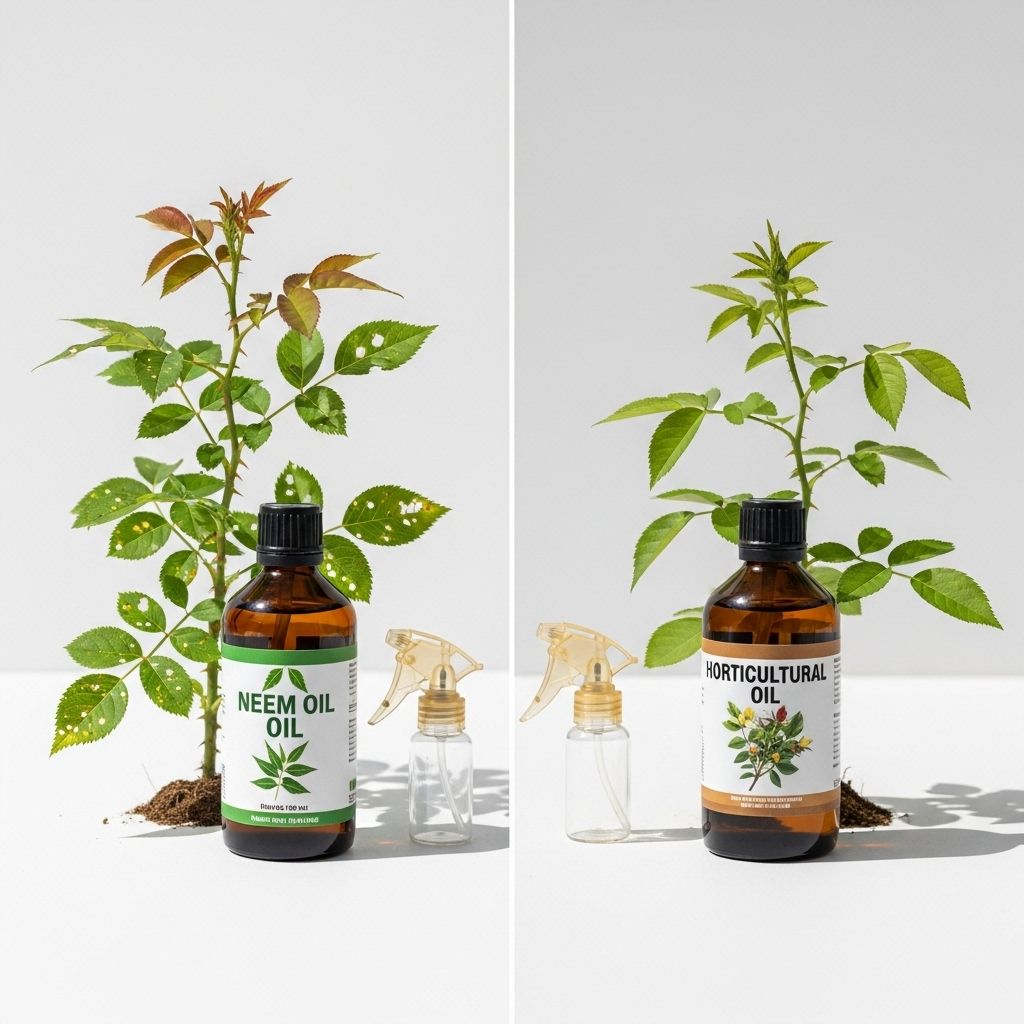Neem Oil Vs Horticultural Oil: Comprehensive Comparison Guide
Compare horticultural oil and neem oil to make informed pest and disease control decisions in your garden.

Image: HearthJunction Design Team
Horticultural Oil vs Neem Oil: What’s the Difference?
When it comes to controlling pests and plant diseases organically, both horticultural oil and neem oil are household names for home gardeners and professional horticulturists alike. Although these two oils are often mentioned together and used for similar purposes, they have distinct characteristics, ingredients, effectiveness, and best-use scenarios. This comprehensive guide unpacks the nitty-gritty details of horticultural oil versus neem oil so you can make the best decision for your gardening needs.
Contents
- Overview: Horticultural Oil & Neem Oil
- How Do Horticultural Oil and Neem Oil Work?
- Main Differences: Horticultural Oil vs Neem Oil
- Pros and Cons of Each Oil
- Best Uses & Application Tips
- Application Safety & Environmental Impact
- Summary Table: Oils Compared
- Frequently Asked Questions (FAQs)
Overview: Horticultural Oil & Neem Oil
Let’s start by defining each product and their origins.
What is Horticultural Oil?
Horticultural oil is an umbrella term for highly refined oils used to manage insects, mites, and select plant diseases. These oils are typically derived from mineral, vegetable, or plant-based sources and have been formulated to minimize the risk of phytotoxicity (plant injury). Commonly called dormant oils or summer oils (depending on use), horticultural oils work mainly by smothering soft-bodied pests. They are most effective when applied during a plant’s dormant season, but many modern oils are safe for use during active growth as well.
What is Neem Oil?
Neem oil is a specific type of horticultural oil extracted from the seeds of the neem tree (Azadirachta indica), native to South Asia. The unique hallmark of neem oil is its active chemical, azadirachtin, which provides both suffocating and toxic effects against a wide range of pests. This makes neem oil not just a smothering agent but an active pest disruptor that can interfere with insect feeding, growth, and egg-laying.
How Do Horticultural Oil and Neem Oil Work?
Mode of Action: Horticultural Oil
- Physical smothering: Oils coat the surface of insects, blocking their spiracles (breathing pores) and suffocating them.
- Egg & mite suppression: Effective against scale insects, aphids, mites, and their eggs through direct contact.
Horticultural oils do not have residual toxicity; they only affect pests present at the time of spraying. As such, proper coverage is crucial for effectiveness.
Mode of Action: Neem Oil
- Smothering action: Like horticultural oil, neem oil suffocates soft-bodied pests on contact.
- Systemic disruption: Thanks to azadirachtin, neem oil interrupts the pest’s hormonal system, inhibiting feeding, growth, and reproduction in many insects.
- Fungal prevention: Neem oil also acts as a protectant against some fungal diseases by preventing spore germination.
Neem oil is most effective during the growing season when pests are active and feeding.
Main Differences: Horticultural Oil vs Neem Oil
| Feature | Horticultural Oil | Neem Oil |
|---|---|---|
| Origin | Mineral, vegetable, or plant-based sources | Extracted from neem tree seeds |
| Main Active Component | Refined oils (no toxic compounds) | Azadirachtin (insecticidal) |
| Pest Control | Physical (smothering only) | Physical and chemical (smothering + hormonal disruption) |
| Mode of Use | Mostly preventative/dormant or direct contact | Preventative and active control; disrupts pest life cycle |
| Plant Safety | Low phytotoxicity if applied as directed | Low risk, but may burn sensitive plants if misapplied |
| Environmental Impact | Low toxicity, minimal residual effect | Low toxicity (except aquatic animals); short residual |
| Organic Gardening Approved | Yes (if non-petroleum based) | Yes |
| Use Timing | Often during dormancy (but also in-season) | During active growth, when pests are present |
Pros and Cons of Each Oil
Horticultural Oil: Pros
- Effective broad-spectrum pest control through suffocation
- Low toxicity to humans, pets, and beneficial insects if used properly
- Suitable for use on a wide variety of plants
- Modern oils are refined to reduce risk of plant damage (phytotoxicity)
- Excellent for winter/dormant spraying on fruit trees and ornamentals
Horticultural Oil: Cons
- Limited to preventative and direct-contact action; no residual control
- Less effective against well-established infestations
- Application requires good timing and complete coverage
- May cause leaf burn if used in hot weather or on sensitive plants
Neem Oil: Pros
- Combines suffocating and systemic pest disruption (azadirachtin)
- Effective against a broad spectrum of insects and some fungal pathogens
- Good for both preventative and active pest control
- Approved for use on edibles, fruits, herbs, and ornamental plants
- Biodegradable and generally safe for birds, mammals, and bees if timed well
Neem Oil: Cons
- May harm aquatic life; avoid runoff into waterways
- Can burn plants if applied in hot, bright sunlight
- Sensitive plants may react negatively to repeated applications
- Repeat treatments often required for full effect
- Strong odor compared to horticultural oils
Best Uses & Application Tips
When to Use Horticultural Oil
- Ideal for dormant season spraying on fruit trees and shrubs
- Control over-wintering pests like scale, aphids, and mites
- Preventative application to protect plants from infestations
- Some formulations safe for use during the growing season
Tip: Ensure full coverage – spray all plant surfaces, including undersides of leaves, for effective control.
When to Use Neem Oil
- Best during active pest outbreaks in the growing season
- Controls aphids, whiteflies, mealybugs, thrips, spider mites, and beetles
- Prevents and manages fungal issues like powdery mildew and black spot
- Safe for almost all garden plants when used as directed
Tip: Apply neem oil during early morning or late evening to protect pollinators like bees.
Application Safety & Environmental Impact
Human and Animal Safety
- Both horticultural oil and neem oil are considered safe for humans and pets when used as directed.
- Neem oil can cause skin and eye irritation – wear protective equipment during application.
- Keep oils out of reach of children and pets.
Environmental Considerations
- Both oils break down rapidly in the environment and have minimal residual effect.
- Neem oil is slightly toxic to fish and aquatic animals – prevent runoff into ponds or streams.
- Apply in calm weather to reduce drift and unintended impact on beneficial insects.
- Follow label instructions for application rates and frequency.
Summary Table: Oils Compared
| Aspect | Horticultural Oil | Neem Oil |
|---|---|---|
| Best Season | Dormant (winter), some for growing season | Growing season (when pests appear) |
| Primary Purpose | Preventative, suffocates pests | Preventative & active treatment, disrupts pests |
| Active Ingredient | Refined mineral/vegetable oils | Azadirachtin (natural compound) |
| Fungal Control | Little to none | Yes (prevents some fungi) |
| Organic Approved | Yes, if non-petroleum based | Yes |
| Safe for Edibles | Most, after pre-harvest intervals | Yes, observe label directions |
Frequently Asked Questions (FAQs)
Is neem oil a horticultural oil?
Yes, neem oil is a type of horticultural oil, but it differs from many other horticultural oils by containing azadirachtin, which gives it added pest-disrupting properties.
Can I use horticultural oil and neem oil interchangeably?
While there is overlap in their uses, they aren’t always interchangeable. Horticultural oil is ideal for smothering pests, especially in the dormant season. Neem oil is better when you need active pest control, including disrupting breeding cycles during the growing season.
Are these oils safe for beneficial insects?
Both oils can affect beneficial insects if sprayed directly. To protect pollinators, apply in early morning or late evening when bees and other helpful bugs are less active.
Can I use these oils on edible plants?
Yes, most horticultural and neem oils are labeled for use on edible plants, including fruits, herbs, and vegetables. Always check the product label for pre-harvest intervals and application instructions.
What precautions should I take when applying oil sprays?
- Spray only when temperatures are below 85°F (29°C) to avoid leaf burn.
- Do not apply to drought-stressed or newly transplanted plants.
- Test spray on a small section first if unsure of sensitivity.
- Wear gloves, goggles, and a mask to avoid skin and eye irritation.
Which oil should I choose for my garden?
If you need a preventative, broad-spectrum, and straightforward pest control for dormant trees and shrubs, horticultural oil is an excellent choice. If you require active pest management during the growing season, especially for stubborn infestations or fungal issues, neem oil offers extra punch, thanks to its systemic effects.
Conclusion
Both horticultural oil and neem oil are valuable tools in the organic gardener’s arsenal against insects and plant diseases. While they share similarities, the presence of azadirachtin in neem oil gives it an extra edge for active pest suppression and fungal control, whereas horticultural oil excels as a preventative and contact treatment, particularly for winter care. Used thoughtfully and according to label directions, either oil can help you maintain a healthy, vibrant, and productive garden without resorting to harsh chemicals.
References
- https://www.epicgardening.com/horticultural-oil-vs-neem-oil/
- https://www.reviewjournal.com/local/local-columns/bob-morris/neem-horticultural-oils-differ-in-toxicity-to-insects/
- https://www.houzz.com/discussions/6010232/neem-oil-or-horticultural-oil
- https://www.youtube.com/watch?v=jsx9I-mJod0
- https://extension.unr.edu/publication.aspx?PubID=3029
Read full bio of Srija Burman












